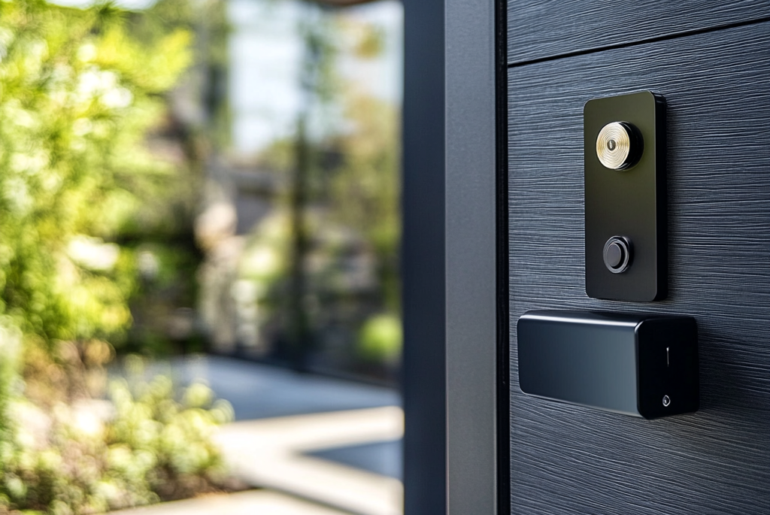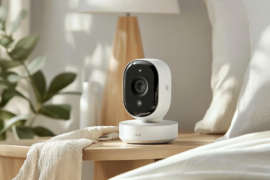This article may contain references to products or services from one or more of our advertisers or partners. We may receive compensation when you click on links to those products or services. Nonetheless, our opinions are our own.
When you’re renting, it’s easy to think, “Why invest in security? That’s the landlord’s problem.” That was me—until the day I came home to a busted window and an empty laptop bag. Suddenly, the cost of inaction felt a lot steeper. What I thought I was saving by skipping a security setup evaporated the moment my apartment became a target.
This article isn’t about fear. It’s about math. I’ll break down the hidden and not-so-hidden costs of a break-in, from stolen electronics to skyrocketing insurance premiums. And I’ll walk through how renters—yes, even those in short-term leases—can deploy smart, affordable security systems that protect their spaces while offering real ROI. You don’t need a mortgage to make a smart investment.
The Real Cost of a Break-In
More Than Just Stuff
Theft isn’t just about losing your TV or laptop. It’s about the time off work to deal with police reports, the stress of filing insurance claims, and the emotional toll of feeling unsafe in your own space. For renters, the disruption can be so intense that some choose to move altogether—adding relocation costs to an already painful bill.
According to FBI data, the average value of property stolen during a home burglary in the U.S. exceeds $2,500. But that number doesn’t account for lost productivity, time spent recovering data, or that gnawing sense of violation. It’s hard to quantify peace of mind, but every renter who’s been through it understands its value.
Opportunity Loss and Daily Disruption
There’s also the ripple effect of disruption. Missed workdays, rescheduled appointments, and eating out because your kitchen’s been compromised—it adds up. If you work from home, a stolen laptop doesn’t just mean lost equipment—it could mean missed deadlines, frustrated clients, or lost revenue.
Some renters also report long-term emotional consequences. Sleep issues, anxiety, and heightened vigilance can linger well after the event. In some cases, therapy becomes another unexpected cost. These stresses don’t just affect your wallet—they impact your wellbeing and relationships.
According to Forbes, the average renters insurance costs about $199 annually for $30,000 in coverage—highlighting just how affordable it can be compared to the cost of a break-in.
Most renters have some form of insurance, and while it can help, it’s far from a silver bullet. Many policies come with deductibles ranging from $500 to $1,000—meaning the first chunk of your loss is on you. Worse, filing a claim could increase your premiums or get your policy dropped altogether.
To fully weigh whether a claim is worth filing, renters need to understand the financial structure of their policy—things like how deductibles interact with co-payments and premium hikes can change the calculus.
Another overlooked detail is what’s buried in your policy paperwork—renters often forget to read their declaration pages closely, even though they spell out exactly what’s covered.
And while some renters skip security under the assumption their landlord’s insurance has them covered, that’s a myth. Landlord policies generally protect the building, not your belongings. So unless you’ve got a policy of your own—and even then—you’re often stuck footing the bill.
Surveillance Without Ownership: Renters Have Options
Finding affordable and effective protection is easier than ever. Business Insider highlights affordable DIY home security systems like SimpliSafe as top picks for renters who want flexibility without long contracts.
To guide renters through the decision-making process, SafeWise compiled a list of top home security systems specifically suited for renters, balancing portability, cost, and ease of installation.
In addition to standalone systems, renters often take the initiative with small upgrades. Small investments renters often make—like better locks, smarter lighting, or even adhesive alarms—can improve both security and perceived property value.
Adding to this, Time magazine outlines a range of smart home security gadgets that are effective without violating lease terms or requiring permanent installation.
You don’t have to drill into walls or install elaborate systems. Many modern surveillance tools are designed for flexibility. Battery-powered cameras, adhesive entry sensors, and mobile control panels mean you can secure your space without voiding your lease. You can even take the system with you when you move.
Some renters also explore insurance options that align with their tech setups—for example, comparing tech-oriented insurers like Hippo against more established players like Lemonade can influence how you approach total coverage.
Companies now offer rental-friendly packages tailored to short-term tenants. Month-to-month plans, self-install kits, and mobile-friendly controls make it possible to start small and scale up. You’re not buying a fortress—you’re investing in peace of mind that moves with you.
Legal and Privacy Considerations
One thing renters often overlook is the legality of installing cameras. Indoor cameras are generally fine as long as you’re not recording shared spaces. But before installing anything outside your unit—like a hallway or entry cam—check local laws and lease agreements. That said, doorbell cams have become a gray area where enforcement varies, and in some cases, landlords are even encouraging tenants to use them.
Equally important is being transparent with roommates or subtenants. Security measures should never become privacy invasions. A short discussion or mutual agreement goes a long way in keeping the household functional.
ROI on Your Terms: Cost-Benefit by the Numbers
If you’re not sure which providers offer the best value, U.S. News & World Report breaks down top renters insurance companies based on price, coverage, and customer satisfaction.
Think of a break-in like a one-time $3,000 punch to the wallet. Then ask: would you pay $20/month to avoid that? That’s the reality for many renters who choose a basic security subscription. Over a year, that’s $240—less than 10% of the potential damage.
Even in high-cost cities, renters have found ways to secure affordable insurance plans that still offer robust protections.
Now factor in the indirect returns: fewer days off work, lower insurance costs, faster police response, and—yes—better sleep. Suddenly, that monthly fee starts looking like a savvy financial move. Security isn’t just about what it stops. It’s about what it preserves.
One concept that’s rapidly gaining traction is investing in a surveillance system for multi-family properties. It’s not just a landlord concern anymore—it’s a shared investment. As tech becomes cheaper and smarter, even individual renters can tap into systems that once only made sense at the building level. Some platforms offer access tiers where tenants can monitor their own unit while the building maintains shared spaces. That’s layered security, and it’s ROI-positive.
Building-Wide Efficiency Gains
From a financial standpoint, shared surveillance systems can improve overall property security while minimizing redundancy. If your building already has a common monitoring service, adding a tenant-facing layer boosts granularity and accountability. It also provides useful footage in disputes over package theft or hallway incidents.
In cities where multi-family break-ins are rising, some landlords are negotiating with tenants to share security costs in exchange for rent credits. That kind of co-investment shows how security can evolve into a partnership—not just a product.
Beyond Tech: Creating a Safer Living Culture
Security doesn’t start and end with gadgets. It’s also about awareness and behavior. Locking doors, reporting suspicious activity, and staying connected with neighbors make a huge difference. But technology helps amplify those efforts.
When everyone in a multi-family setup buys in—even just by using doorbell cameras or motion detectors—it builds a culture of alertness. Criminals notice. Studies show that visible security measures significantly reduce the likelihood of a break-in. It’s not just about stopping one event—it’s about deterring all of them.
Community Accountability
When renters talk, things change. A group chat for the building, a simple community bulletin board, or even informal “hallway meetings” can be powerful tools. It’s not about playing cop—it’s about watching each other’s backs.
Security-minded tenants often become informal leaders in their complexes, helping neighbors secure deliveries or identify faulty locks. This kind of social vigilance adds another layer of ROI—not just financial, but psychological. Feeling connected makes everyone feel safer.
Renter Security as a Financial Strategy
I used to think of home security as something you install after you buy a house and settle down. But the truth is, threats don’t wait for mortgages. Renters have as much at stake—maybe more—because they’re often more exposed.
Investing in smart, renter-friendly security isn’t just about feeling safer—it’s about making a financial decision that pays off. For a small upfront cost and minimal commitment, you get something that saves you time, money, and stress. And when you think of it that way, skipping security is the real risk.

Reviewed and edited by Albert Fang.
See a typo or want to suggest an edit/revision to the content? Use the comment form below for feedback.
At FangWallet, we value editorial integrity and open collaboration in curating quality content for readers to enjoy. Much appreciated for the assist.
Did you like our article and find it insightful? We encourage sharing the article link with family and friends to benefit as well - better yet, sharing on social media. Thank you for the support! 🍉
Article Title: Smart Investments: Evaluating the ROI of Home Security Systems in Rentals
https://fangwallet.com/2025/04/17/smart-home-security-for-renters/The FangWallet Promise
FangWallet is an editorially independent resource - founded on breaking down challenging financial concepts for anyone to understand since 2014. While we adhere to editorial integrity, note that this post may contain references to products from our partners.
The FangWallet promise is always to have your best interest in mind and be transparent and honest about the financial picture.
Become an Insider
Editorial Disclaimer: The editorial content on this page is not provided by any of the companies mentioned. The opinions expressed here are the author's alone.
The content of this website is for informational purposes only and does not represent investment advice, or an offer or solicitation to buy or sell any security, investment, or product. Investors are encouraged to do their own due diligence, and, if necessary, consult professional advising before making any investment decisions. Investing involves a high degree of risk, and financial losses may occur including the potential loss of principal.
Source Citation References:
+ Inspo
Investopedia. (n.d.). Investopedia. https://www.investopedia.com/
Wikipedia, the free encyclopedia. (n.d.). https://www.wikipedia.org/
Fang, A. (n.d.). FangWallet — Personal Finance Blog on Passive Income Ideas. FangWallet. https://fangwallet.com/
Google Scholar. (n.d.). Google Scholar. https://scholar.google.com/
There are no additional citations or references to note for this article at this time.











































